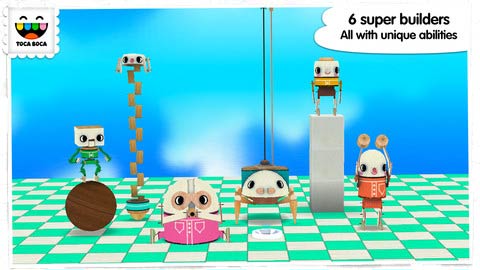
I’ve been playing a little with Toca Boca‘s latest iOS toy: Toca Builders.
As you’d expect from Toca Boca, it’s charming: a straightforward, paired down implementation of an idea, with unambiguous UI and lovely character design.
Builders is Toca’s take on a block construction toy for small children. Initially, it might seem a bit clunky, a Minecraft pastiche that’s not nearly so sophisticated as Mojang’s original. After all, it’s a tiny play area compared to Minecraft – six blocks of height and relatively small X-Y dimensions.
It’s the plural in the title that makes it so interesting, though: builders. This is not (just) a game in which the user is a builder; it is a game about six individual builders (pictured above). Each has their own different ability: most can both construct and desturct; almost all can control the colour of blocks; some are better at changing blocks after the fact, others at sketching with. They each control slightly differently – and they each manifest in the landscape. You can swap between builders with a simple or menu, or by tapping on any that you can see.
It’s the manifestation and personification of the four builders that suddenly clicked for me. As I played this, I realised what it really was: Minecraft through the eyes of Seymour Papert. Lego as LOGO.
Papert explained the LOGO turtle as an “object-for-thinking-with“. Not just a device to command, attached to a programming language; a device that you see the world through. Or as Papert says in Mindstorms, his wonderful book about the development and intent behind LOGO:
“objects in which there is an intersection of cultural presence, embedded knowledge, and the possibility for personal identification.”
He makes what I think is a clearer point later, though, and which I think Toca Builders captures perfectly:
Even the simplest Turtle work can open new opportunities for sharpening one’s thinking about thinking: Programming the Turtle starts by making one reflect on how one does oneself what one would like the Turtle to do. Thus teaching the Turtle to act or to ‘think’ can lead one to reflect on one’s own actions and thinking. And as children move on, they program the computer to make more complex decisions and find themselves engaged in reflecting on more complex aspects of their own thinking.
Papert is sometimes quite wordy. When I explain this to people, I tend to say: the value of the Turtle is that when you are stuck, you solve the problem by pretending to be the Turtle. This is especially valuable for young learners; as Papert points out later:
Children can identify with the Turtle, and are thus able to bring their knowledge of their bodies and how they move into their work of learning formal geomtetry
There are some lovely photos in Mindstorms of kids on a playing field, practicing Logo; one of them is being the Turtle, and the others are telling her what to do. The second you act out a program for yourself (or watch another child follow your instructions to the letter), you see how literal you need to be, or which line of code is ambiguous. You begin to see how the computer processes information (“thinks” being, unfortunately, an entirely inaccurate word).
This kind of embodied representation of computational logic is very rare. Often, the hard things in computer science are very abstract. I do not know how to “pretend to be the compiler”; I just have to trust input and output.
Toca Builders takes the abstract building of Minecraft – tools attached to a disembodied perspective (albeit one hindered by some degree of personhood – factors such as gravity, and so forth) – and embodies them to help younger children answer the question which tool would you use to place a block where you need to? Or sometimes backwards: which block shall we place next? It is not quite as freeform as Minecraft, but it actually forces the user to think a little harder about planning ahead, lining up his builders, and which builders go together well. Measure twice, cut once.
To that end, it’s much more like real-world building.
Papert was very clear about one particular point: the value of this is not to think in mechanical ways; it’s actually the opposite. By asking children to think in a mechanical way temporarily, they end up thinking about thinking more: they learn that there are many ways to approach a problem, and they can choose which way to think about things; which might be most appropriate.
And so Toca Builders is, in many ways, like all good construction toys: it’s about more than just building. It’s about planning, marshalling, making use of a limited set of tools to achieve creative goals. And all the while, helping the user understand those tools by making them appear in the world, taking up space in it, colliding with one another, and needing moving. All so that you can answer the question when you’re stuck: well, if you were Blox the Hammer, what would you do?
Some of what looks like clunkiness, then, is actually a subtle piece of design.
If you’re interested in the value of using computers to teach – not using computers to teach about computers, but using computers to teach about the world, then Mindstorms is a must-read. It’s easy to dismiss LOGO for its simplicity, and to forget the various paradigms it bends and breaks (more so than many programming languages) – and it’s remarkable to see just how long ago Papert and his collaborators were touching on ideas that are still fresh and vital today.